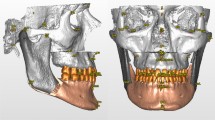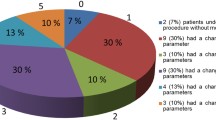Abstract
Introduction
Orthognathic surgery aims to improve the facial aesthetics while maintaining stable jaw form and function. Lateral cephalometry provides objective data used in pre-op mock surgery to predict movement of the maxilla and mandible during orthognathic procedures.
Patient and Methods
A prospective cohort study was conducted on 30 adult orthognathic surgery patients. Mock jaw surgery predicted two-dimensional (horizontal and vertical) linear movement of maxilla and mandible. Operative procedures performed were bilateral sagittal split osteotomy and Le Fort I osteotomy. Seven-day pre-op cephalogram (T1) was compared to 7th day post-op cephalogram (T2) to assess hard tissue movement of point A (maxilla) and point B (mandible) using Cartesian (X–Y) plane.
Results
The difference between predicted values to the 7th day post-op outcome results was statistically insignificant (p value less than 0.001).
Conclusion
Planning in orthognathic surgery using digitized two-dimensional cephalometric tracings and mock jaw surgery produces predictable results.






Similar content being viewed by others
References
Legan HL, Burstone CJ (1980) Soft tissue cephalometric analysis for orthognathic surgery. J Oral Surg 38(10):744–751
Lew KK, Low FC, Yeo JF, Loh HS (1990) Evaluation of soft tissue profile following intraoral ramus osteotomy in Chinese adults with mandibular prognathism. Int J Adult Orthodon Orthognath Surg 5:189–197
Proffit WR, White RP (1990) Jr Who needs surgical-orthodontic treatment? Int J Adult Orthodon Orthognath Surg 5:81–89
Barnard D, Birnie D (1990) Scope and limitations of orthognathic surgery. Dental Update 17:63–69
Friede H, Kahnberg KE, Adell R, Ridell A (1987) Accuracy of cephalometric prediction in orthognathic Surgery. J Oral Maxillofac Surg 45:754–760
Hack GA, Mol van Otterloo JJ, Nanda R. Long term stability and prediction of soft tissue changes after Le Fort I surgery. Am J Orthod Dentofacial Orthop. 1993; 104(6): 544-55
Gimenez CMM, Bertoz FA, Gabrielli MAC, Magro Filho O, Garcia I, Pereira Filho VA (2013) Cephalometric evaluation of the predictability of bimaxillary surgical-orthodontic treatment outcomes in long face pattern patients: a retrospective study. Dental Press J Orthod 18(5):53–58
Bryan DC, Hunt NP (1993) Surgical accuracy in orthognathic surgery. Br J Oral Maxillofac Surg 31:343–349
Csaszar GR, Niederdellmann H (2000) Reliability of bimaxillary surgical planning with the 3-D orthognathic surgery simulator. Int J Adult Orthodon Orthognath Surg 15:51–58
Gil JN, Claus JD, Manfro R, Lima SM (2007) Predictability of maxillary repositioning during bimaxillary surgery: accuracy of a new technique. Int J Oral Maxillofac Surg 36:296–300
Kiyak HA, Vitaliano PP, Crinean J (1988) Patients’ expectations as predictors of orthognathic surgery outcomes. Health Psychol 7(3):251–268
Thallita PQ, Gulinelli GL, Souza FA, da Silva LS (2010) Assessment of the accuracy of cephalometric prediction tracings in patients subjected to orthognathic surgery in the mandible. Dental Press J Orthod 15(4):117–123
Pospisil OA (1987) Reliability and feasibility of prediction tracing in orthognathic surgery. J Craniomaxillofac Surg 15(2):79–83
Author information
Authors and Affiliations
Corresponding author
Ethics declarations
Conflict of interest
The authors declare that they have no conflict of interests.
Additional information
Publisher's Note
Springer Nature remains neutral with regard to jurisdictional claims in published maps and institutional affiliations.
Rights and permissions
About this article
Cite this article
Rodrigues, E., Dhupar, V. & Akkara, F. Understanding Predictability Error in Orthognathic Surgery. J. Maxillofac. Oral Surg. 18, 474–478 (2019). https://doi.org/10.1007/s12663-018-01181-x
Received:
Accepted:
Published:
Issue Date:
DOI: https://doi.org/10.1007/s12663-018-01181-x




